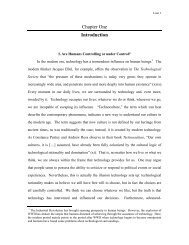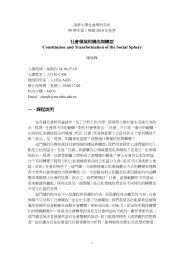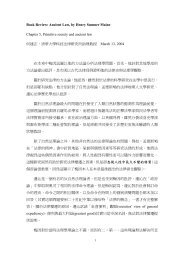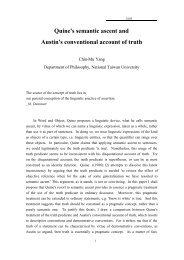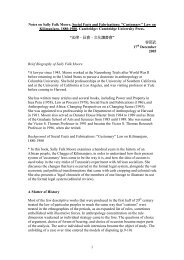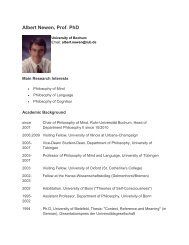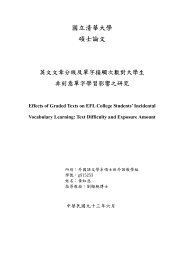The case against grammar correction in L2 writing classes.
The case against grammar correction in L2 writing classes.
The case against grammar correction in L2 writing classes.
Create successful ePaper yourself
Turn your PDF publications into a flip-book with our unique Google optimized e-Paper software.
Language Learn<strong>in</strong>g 46:2, June 1996, pp. 327-369<br />
Review Article<br />
<strong>The</strong> Case Aga<strong>in</strong>st Grammar Correction<br />
<strong>in</strong> <strong>L2</strong> Writ<strong>in</strong>g Classes<br />
John Truscott<br />
National Ts<strong>in</strong>g Hua University<br />
<strong>The</strong> paper argues that <strong>grammar</strong> <strong>correction</strong> <strong>in</strong> <strong>L2</strong> writ<strong>in</strong>g<br />
<strong>classes</strong> should be abandoned, for the follow<strong>in</strong>g reasons:<br />
(a) Substantial research shows it to be <strong>in</strong>effective and none<br />
shows it to be helpful <strong>in</strong> any <strong>in</strong>terest<strong>in</strong>g sense; (b) for both<br />
theoretical and practical reasons, one can expect it to be<br />
<strong>in</strong>effective; and (c) it has harmful effects. I also consider<br />
and reject a number of arguments previously offered <strong>in</strong><br />
favor of <strong>grammar</strong> <strong>correction</strong>.<br />
In second language (<strong>L2</strong>) writ<strong>in</strong>g courses, <strong>grammar</strong> <strong>correction</strong><br />
is someth<strong>in</strong>g of an <strong>in</strong>stitution. Nearly all <strong>L2</strong> writ<strong>in</strong>g teachers do<br />
it <strong>in</strong> one form or another; nearly everyone who writes on the<br />
subject recommends it <strong>in</strong> one form or another. Teachers and<br />
researchers hold a widespread, deeply entrenched belief that<br />
<strong>grammar</strong> <strong>correction</strong> should, even must, be part of writ<strong>in</strong>g courses.<br />
But on what do they base this belief? <strong>The</strong> literature conta<strong>in</strong>s<br />
This paper has benefitted from the comments of Nathan Jones, Johanna<br />
Katchen, Hsien-Ch<strong>in</strong> Liou, and Yenlung Shieh; not, of course, that these<br />
helpful people agree with everyth<strong>in</strong>g I have to say.<br />
Correspondence concern<strong>in</strong>g this article should be addressed to the author<br />
at Department of Foreign Languages, National Ts<strong>in</strong>g Hua University,<br />
Hs<strong>in</strong>chu, Taiwan. Internet: truscott@fl.nthu.edu.tw.<br />
327
328 Language Learn<strong>in</strong>g Vol. 46, No. 2<br />
few serious attempts to justify the practice on empirical grounds;<br />
those that exist pay scant attention to the substantial research<br />
that has found <strong>correction</strong> <strong>in</strong>effective or harmful. Most writ<strong>in</strong>g on<br />
the subject simply takes the value of <strong>grammar</strong> <strong>correction</strong> for<br />
granted. Thus, authors often assume the practice is effective,<br />
without offer<strong>in</strong>g any argument or cit<strong>in</strong>g any evidence. When<br />
someone cites evidence, it generally consists of only one or two<br />
token sources, with no critical assessment of them.<br />
Researchers have similarly failed to look critically at the<br />
nature of the <strong>correction</strong> process. Work on the subject rarely<br />
considers the many practical problems <strong>in</strong>volved <strong>in</strong> <strong>grammar</strong><br />
<strong>correction</strong> and largely ignores a number of theoretical issues<br />
which, if taken seriously, would cast doubt on its effectiveness.<br />
F<strong>in</strong>ally, researchers have paid <strong>in</strong>sufficient attention to the<br />
side effects of <strong>grammar</strong> <strong>correction</strong>, such as its effect on students'<br />
attitudes, or the way it absorbs time and energy <strong>in</strong> writ<strong>in</strong>g <strong>classes</strong>.<br />
Commentators seem to feel that we cannot elim<strong>in</strong>ate such problems<br />
through limited adjustments <strong>in</strong> the <strong>correction</strong> process, so we<br />
simply have to live with them. <strong>The</strong>y assume that <strong>grammar</strong><br />
<strong>correction</strong> must be used <strong>in</strong> writ<strong>in</strong>g <strong>classes</strong>, regardless of the<br />
problems it creates; this assumption is very rarely discussed<br />
seriously.<br />
Grammar <strong>correction</strong> is too important to be dealt with so<br />
casually. We have an obligation to our students and to our<br />
profession: to go beyond this uncritical acceptance and to look<br />
more seriously at the evidence, at the logic of <strong>correction</strong>, and at the<br />
problems it creates. This will mean see<strong>in</strong>g the subject through the<br />
eyes of a skeptic, which is what I propose to do.<br />
'My thesis is that <strong>grammar</strong> <strong>correction</strong> has no place <strong>in</strong> writ<strong>in</strong>g<br />
courses and should be abandoned. <strong>The</strong> reasons are: (a) Research<br />
evidence shows that <strong>grammar</strong> <strong>correction</strong> is <strong>in</strong>effective; (b) this<br />
lack of effectiveness is exactly what should be expected, given the<br />
nature of the <strong>correction</strong> process and the nature of language<br />
learn<strong>in</strong>g; (c) <strong>grammar</strong> <strong>correction</strong> has significant harmful effects;<br />
and (d) the various arguments offered for cont<strong>in</strong>u<strong>in</strong>g it all lack<br />
merit.
Truscott 329<br />
Before proceed<strong>in</strong>g with the argument, though, I need to<br />
clarify a few po<strong>in</strong>ts. First, I do not deny the value of grammatical<br />
accuracy; the issue is whether or not <strong>grammar</strong> <strong>correction</strong> can<br />
contribute to its development. Nor do I generally reject feedback<br />
as a teach<strong>in</strong>g method; I will have very little to say about responses<br />
to the content, organization, or clarity of a composition, for<br />
<strong>in</strong>stance, and I certa<strong>in</strong>ly will not suggest that such responses are<br />
misguided. F<strong>in</strong>ally, the key term needs some clarification: By<br />
<strong>grammar</strong> <strong>correction</strong>, I mean <strong>correction</strong> of grammatical errors for<br />
the purpose of improv<strong>in</strong>g a student's ability to write accurately.<br />
This <strong>correction</strong> comes <strong>in</strong> many different forms, but for present<br />
purposes such dist<strong>in</strong>ctions have little significance, simply because<br />
there is no reason to th<strong>in</strong>k any of the variations should be used <strong>in</strong><br />
writ<strong>in</strong>g <strong>classes</strong>, and there is considerable reason to th<strong>in</strong>k they are<br />
all misguided.<br />
Grammar Correction Does Not Work<br />
A large number of studies have attempted to show the effects<br />
(or lack of effects) of <strong>grammar</strong> <strong>correction</strong>. <strong>The</strong>ir general logic is<br />
straightforward: <strong>The</strong> researchers compare the writ<strong>in</strong>g of students<br />
who have received <strong>grammar</strong> <strong>correction</strong> over a period of time with<br />
that of students who have not. If <strong>correction</strong> is important for<br />
learn<strong>in</strong>g, then the former students should be better writers, on<br />
average, than the latter. If the abilities of the two groups do not<br />
differ, then <strong>correction</strong> is not helpful. <strong>The</strong> third possibility, of<br />
course, is that the uncorrected students will write better than the<br />
corrected ones—<strong>in</strong> which <strong>case</strong>, <strong>correction</strong> is apparently harmful.<br />
Evidence Aga<strong>in</strong>st Grammar Correction<br />
To beg<strong>in</strong> with, there is a great deal of evidence regard<strong>in</strong>g first<br />
language (LI) writ<strong>in</strong>g. Knoblauch and Brannon (1981) and<br />
Hillocks (1986) have done extensive reviews of this research (see<br />
also Krashen, 1984; Leki, 1990). <strong>The</strong>y looked at many studies,<br />
<strong>in</strong>clud<strong>in</strong>g research done with various types of students and many
530 Language Learn<strong>in</strong>g Vol. 46, No. 2<br />
different types of <strong>grammar</strong> <strong>correction</strong>. <strong>The</strong>y found that <strong>correction</strong><br />
had little or no effect on students' writ<strong>in</strong>g ability. It made no<br />
difference who the students were, how many mistakes were<br />
corrected, which mistakes were corrected, how detailed the comments<br />
were, or <strong>in</strong> what form they were presented. <strong>The</strong> <strong>correction</strong>s<br />
had no effect. <strong>The</strong> conclusion for LI, then, is clear: Correction is<br />
not helpful.<br />
<strong>The</strong>se studies on LI learn<strong>in</strong>g certa<strong>in</strong>ly do not prove that<br />
<strong>correction</strong> is <strong>in</strong>effective <strong>in</strong> <strong>L2</strong> language learn<strong>in</strong>g; conceivably a<br />
technique that is not helpful <strong>in</strong> the one <strong>case</strong> could be helpful <strong>in</strong> the<br />
other. But they certa<strong>in</strong>ly provide strong grounds for doubt; <strong>in</strong><br />
view of their results, it would be folly to assume, without strong<br />
evidence, that <strong>correction</strong> is useful <strong>in</strong> <strong>L2</strong> learn<strong>in</strong>g. In other words,<br />
the effect of the LI research is to place the burden of proof firmly<br />
on those who would claim that <strong>correction</strong> is helpful.<br />
So I turn now to the research on <strong>L2</strong> learn<strong>in</strong>g. Can a <strong>case</strong> be<br />
made that <strong>correction</strong> works? Clearly and unambiguously not. In<br />
fact, the <strong>L2</strong> evidence fits very well with that from the LI studies;<br />
<strong>correction</strong> is clearly <strong>in</strong>effective.<br />
Hendrickson (1978) reviewed the available research and<br />
concluded that little was known. He claimed that learners should<br />
be corrected, but the work he reviewed did not support such a<br />
view. His own work (1978, and <strong>in</strong> more detail <strong>in</strong> Hendrickson,<br />
1981) <strong>in</strong>dicated that correct<strong>in</strong>g all errors was no better than<br />
correct<strong>in</strong>g only those that produced communicative problems:<br />
Neither method had any significant effects. A few more recent<br />
papers (Krashen, 1992; Leki, 1990; VanPatten, 1986a, 1986b)<br />
have briefly reviewed the evidence, all of them reach<strong>in</strong>g the same<br />
conclusion: Grammar <strong>correction</strong> is <strong>in</strong>effective.<br />
Look<strong>in</strong>g at the rest of the literature, one has no difficulty<br />
understand<strong>in</strong>g these pessimistic assessments. Cohen and Bobb<strong>in</strong>s<br />
(1976),'for <strong>in</strong>stance, exam<strong>in</strong><strong>in</strong>g the written <strong>correction</strong>s received<br />
by three students <strong>in</strong> an advanced ESL course, concluded that "the<br />
<strong>correction</strong>s did not seem to have any significant effect on students'<br />
errors" (p. 50), <strong>The</strong>y found that the <strong>correction</strong>s were not well done;<br />
they believed that this was the real cause of students' problems,
Truscott 331<br />
but offered no reason that better-done <strong>correction</strong> would have<br />
helped. ~,<br />
Semke's (1984) large, 10-week study of German students<br />
produced similar results. She divided the students <strong>in</strong>to four<br />
'; groups, each receiv<strong>in</strong>g a different type of feedback. Group 1<br />
^received only comments on content, with no concern for errors.;<br />
Group 2 received only comments on errors. Group 3 received both<br />
types of comments, and Group 4 had their errors po<strong>in</strong>ted out and<br />
were expected to make <strong>correction</strong>s themselves. Semke found no<br />
significant differences among the groups <strong>in</strong> the accuracy of their<br />
writ<strong>in</strong>g. In addition, Group 1 (comments on content only) was<br />
significantly better than all the others on fluency and on a cloze<br />
test. Thus, feedback on errors was not only unhelpful, but also<br />
harmful to learners. Those who received comments on content<br />
' plus <strong>correction</strong> were significantly <strong>in</strong>ferior to those who received<br />
;! only comments on content. Semke also found Group 4 (self<strong>correction</strong>)<br />
<strong>in</strong>ferior to all the other groups on fluency 1 —evidence<br />
<strong>aga<strong>in</strong>st</strong> the use of a technique frequently recommended <strong>in</strong> the:D<br />
S literature (but always with little or no support<strong>in</strong>g evidence; e.g.^<br />
JBartram & Walton, 1991; Hendrickson, 1978, 1980; Higgs, 1979;t<br />
?Hyland, 1990; Raimes, 1983). |i<br />
Grammar <strong>correction</strong>'s futility also showed <strong>in</strong> a study by<br />
; Robb, Ross, and Shortreed (1986). <strong>The</strong>y used four very different<br />
types of feedback: (a) explicit <strong>correction</strong>, <strong>in</strong>dicat<strong>in</strong>g the errors and<br />
the correct forms; (b) the use of a <strong>correction</strong> code to po<strong>in</strong>t out type<br />
i and location of errors; (c) the use of highlight<strong>in</strong>g to <strong>in</strong>dicate the<br />
locations of errors, without any explanation; and (d) a marg<strong>in</strong>al<br />
tally of the number of errors <strong>in</strong> each l<strong>in</strong>e, with no <strong>in</strong>dication of<br />
!: what the errors were or where <strong>in</strong> the l<strong>in</strong>e they were located. In all<br />
four conditions, students were to rewrite their compositions,<br />
mak<strong>in</strong>g the appropriate changes. At the end of the course, the<br />
authors found no significant differences <strong>in</strong> students' writ<strong>in</strong>g<br />
ability.<br />
• Robb et al.'s (1986) study could have been made more clear<br />
I and compell<strong>in</strong>g by the <strong>in</strong>clusion of a fifth group, which would have<br />
received no feedback of any k<strong>in</strong>d. But the negative implications
332 Language Learn<strong>in</strong>g Vol. 46, No<br />
for <strong>grammar</strong> <strong>correction</strong> are reasonably clear nonetheless. For one<br />
th<strong>in</strong>g, the amount of <strong>in</strong>formation conta<strong>in</strong>ed <strong>in</strong> the feedback varied<br />
so much among the four groups that one would expect significant<br />
differences among them if the <strong>in</strong>formation were at all valuable.<br />
That there were no differences argues strongly <strong>aga<strong>in</strong>st</strong> its hav<strong>in</strong>g<br />
any value. Moreover, the practical difference between the hypothetical<br />
fifth group and the actual fourth group would have been<br />
small. In fact, Frantzen and Rissel (1987) found that, even when<br />
told the exact location of an error, learners usually could not<br />
determ<strong>in</strong>e exactly what that error was; <strong>in</strong> view of this f<strong>in</strong>d<strong>in</strong>g, it<br />
would be extremely surpris<strong>in</strong>g if the learners <strong>in</strong> the fourth group<br />
ga<strong>in</strong>ed any <strong>in</strong>sights from their much more limited <strong>in</strong>formation. So<br />
one can reasonably treat these learners as a control group. <strong>The</strong><br />
lack of any contrast between them and the groups that received<br />
more <strong>in</strong>formative feedback thus provides good evidence for the<br />
<strong>in</strong>effectiveness of <strong>grammar</strong> <strong>correction</strong>.<br />
More evidence of this <strong>in</strong>effectiveness comes from Kepner<br />
(1991), who experimented with two forms of feedback <strong>in</strong> <strong>in</strong>termediate<br />
Spanish as a foreign language (FL) courses. Half the<br />
participants received comprehensive <strong>correction</strong> on sentence-level<br />
errors with brief explanations or statements of rules; the other<br />
half received comments on content <strong>in</strong>stead, written <strong>in</strong> the target<br />
language. Kepner then checked their sixth assignment, written<br />
after 12 weeks of <strong>in</strong>struction, for grammatical accuracy, as measured<br />
by a count of all <strong>grammar</strong> and vocabulary errors. Kepner<br />
checked the quality of the writ<strong>in</strong>g's content by measur<strong>in</strong>g the<br />
number of "higher-level propositions" it conta<strong>in</strong>ed. Kepner<br />
found no significant differences <strong>in</strong> accuracy. However, students<br />
who had received content-oriented feedback were significantly<br />
superior <strong>in</strong> the measure of content. <strong>The</strong>se results held for both<br />
high-verbal-ability and low-verbal-ability students, and there<br />
were no significant <strong>in</strong>teractions between the variables. Thus,<br />
once aga<strong>in</strong> <strong>grammar</strong> <strong>correction</strong> was not helpful.<br />
Sheppard (1992) experimented with two different types of<br />
feedback <strong>in</strong> a writ<strong>in</strong>g class. One group received comprehensive<br />
responses to errors, us<strong>in</strong>g a <strong>correction</strong> code, and discussed their
Truscott 333<br />
errors (and noth<strong>in</strong>g else) <strong>in</strong> conferences with the <strong>in</strong>structor. For<br />
the other group, feedback and conferences dealt exclusively with<br />
the content of the students' writ<strong>in</strong>g. Thus, if error <strong>correction</strong> were<br />
helpful, the content group should have suffered on measures of<br />
grammatical ability. However, Sheppard found no advantage for<br />
the error-<strong>correction</strong> group, the results actually favor<strong>in</strong>g the content<br />
group. In accuracy of verb forms, there were no differences<br />
between the groups, both improv<strong>in</strong>g significantly. For accurate<br />
mark<strong>in</strong>g of sentence boundaries (through appropriate punctuation),<br />
the content group made significant ga<strong>in</strong>s, the error group<br />
did not, and the difference was significant. F<strong>in</strong>ally, on a measure<br />
of the complexity of students' writ<strong>in</strong>g—the relative frequency<br />
with which they used subord<strong>in</strong>ate clauses—the content group had<br />
no significant changes, although the error group got significantly<br />
worse (though there was no significant difference between the two<br />
groups on this measure). Sheppard attributed this latter result to<br />
an avoidance strategy on the part of the students who had been<br />
frequently corrected—their fear of mak<strong>in</strong>g mistakes led them to<br />
limit the complexity of their writ<strong>in</strong>g.<br />
Thus Sheppard's (1992) work resembles that ofSemke (1984)<br />
and Kepner (1991). Correction was not only unhelpful <strong>in</strong> these<br />
studies but also actually h<strong>in</strong>dered the learn<strong>in</strong>g process.<br />
F<strong>in</strong>ally, a few additional studies are worthy of notice. Work<br />
by Ste<strong>in</strong>bach, Bereiter, Burtis, and Bertrand (cited <strong>in</strong> Carroll &<br />
Swa<strong>in</strong>, 1993) found that feedback on compositions had no benefits<br />
for students' <strong>grammar</strong>, diction, or mechanics. Similarly, VanPatten<br />
(1986b, 1988) described two studies by Dvorak, one cover<strong>in</strong>g a full<br />
year, <strong>in</strong> which lack of <strong>correction</strong> did not affect students' accuracy.<br />
Dvorak's research was primarily concerned with oral <strong>correction</strong>,<br />
but apparently covered some written work as well.<br />
Some Possible Limitations of the. Research;'\ •.<br />
<strong>The</strong> studies discussed above show that the situation for <strong>L2</strong> is<br />
the same as for LI: Grammar <strong>correction</strong> <strong>in</strong> writ<strong>in</strong>g courses is not<br />
helpful. Any <strong>in</strong>terest<strong>in</strong>g research is subject to alternative <strong>in</strong>ter-
334 Language Learn<strong>in</strong>g Vol. 46, No. 2<br />
pretations, though. <strong>The</strong> variable relevant here is the use or<br />
nonuse of <strong>grammar</strong> <strong>correction</strong>, but a number of other factors could<br />
have <strong>in</strong>fluenced the results of the experiments. However, all the<br />
obvious candidates can be discounted.<br />
First, the results probably cannot be expla<strong>in</strong>ed by the difference<br />
between FL and SL learn<strong>in</strong>g, the identity of the target<br />
language, or the learners' LI. <strong>The</strong> studies that found <strong>correction</strong><br />
<strong>in</strong>effective <strong>in</strong>cluded ESL, EFL, German FL, and Spanish FL;<br />
besides, the students' orig<strong>in</strong>s and LIs differed widely.<br />
Another factor that can probably be dismissed is the form of<br />
<strong>correction</strong> used. <strong>The</strong> studies varied between direct techniques<br />
(learners given correct forms for each error) and <strong>in</strong>direct ones<br />
(errors po<strong>in</strong>ted out, usually by means of a code, but correct forms<br />
not given). In addition, Robb et al. (1986) alone <strong>in</strong>cluded four<br />
different degrees of directness. <strong>The</strong> <strong>case</strong> is somewhat less clear for<br />
the other major variable of this sort—the difference between<br />
comprehensive and selective <strong>correction</strong>. Most of the studies<br />
reviewed here relied on the former, but Hendrickson (1981) used<br />
both types and found no difference between them. Also, the LI<br />
research described above found comprehensiveness of <strong>correction</strong><br />
irrelevant. Additional reasons to doubt the value of selective<br />
<strong>correction</strong> will be presented below.<br />
Another explanation of the results is that the <strong>correction</strong> used<br />
<strong>in</strong> these studies could have had a delayed effect that did not show<br />
up dur<strong>in</strong>g the research. However, available evidence argues<br />
<strong>aga<strong>in</strong>st</strong> such a view: Robb et al.'s (1986) study, cover<strong>in</strong>g mid-April<br />
to mid-January, showed no more evidence of beneficial effects<br />
than did studies last<strong>in</strong>g a s<strong>in</strong>gle semester or a s<strong>in</strong>gle quarter. Nor<br />
did Dvorak's year-long study. Besides the lack of any a priori<br />
reasons to expect delayed effects, this (admitedly limited) research<br />
makes the possibility of such effects rather remote.<br />
Another possibility: <strong>The</strong> results were affected by the types of<br />
assessment used. However, this argument also has plausibility<br />
problems, for several reasons. First, all the studies used actual<br />
writ<strong>in</strong>g samples from the students (rather than rely<strong>in</strong>g on <strong>grammar</strong><br />
exercises, for <strong>in</strong>stance); so <strong>in</strong> terms of authenticity (Bachman,
Truscott 335<br />
1991; Hoekje & L<strong>in</strong>nell, 1994; Skehan, 1988,1989) this work fares<br />
quite well. Second, they used a variety of measures. For accuracy,<br />
these <strong>in</strong>cluded counts of all grammatical and lexical errors <strong>in</strong> two<br />
studies (plus style <strong>in</strong> one of them), verb form problems <strong>in</strong> two<br />
others, and an <strong>in</strong>dependent measure of sentence boundaries <strong>in</strong><br />
one. <strong>The</strong>y also frequently <strong>in</strong>cluded measures of quantity and<br />
complexity of writ<strong>in</strong>g, and one study added a cloze test. Not one<br />
of these measurements found any significant advantages for<br />
students whose writ<strong>in</strong>g had been corrected. Third, the measures<br />
used <strong>in</strong> some of the studies did f<strong>in</strong>d significant differences between<br />
groups—always favor<strong>in</strong>g the uncorrected students. Some also<br />
found significant ga<strong>in</strong>s (and occasionally losses) from pretest to<br />
posttest. Clearly, these measures can detect such differences.<br />
Thus, that none of them found any significant advantages of any<br />
sort for corrected students must be taken seriously.<br />
Similar comments apply to differences <strong>in</strong> the type of <strong>in</strong>struction<br />
used <strong>in</strong> the various studies. <strong>The</strong> authors provided only<br />
limited <strong>in</strong>formation, but this <strong>in</strong>formation suggests substantial<br />
variation. In Robb et al.'s (1986) research, most of the class time<br />
was devoted to <strong>correction</strong> practice and sentence-comb<strong>in</strong><strong>in</strong>g. Kepner<br />
(1991) described her <strong>classes</strong> as proficiency-based, with a large<br />
concern for personal growth and the development of faith.<br />
Sheppard's (1992) students, <strong>in</strong> addition to extensive writ<strong>in</strong>g<br />
experience, read two novels and underwent selective <strong>grammar</strong><br />
<strong>in</strong>struction (on topics overlapp<strong>in</strong>g the po<strong>in</strong>ts later exam<strong>in</strong>ed <strong>in</strong><br />
their writ<strong>in</strong>g). Thus, the consistent failure of <strong>grammar</strong> <strong>correction</strong><br />
probably cannot be attributed to any particular form of <strong>in</strong>struction;<br />
the studies vary substantially <strong>in</strong> this regard.<br />
Nor can the results be expla<strong>in</strong>ed by what was done or not<br />
done after <strong>correction</strong>s were made. In Kepner (1991), students<br />
apparently were not required to do anyth<strong>in</strong>g with the <strong>correction</strong>s,<br />
but rewrit<strong>in</strong>g was a requirement for all the students <strong>in</strong> Robb et<br />
al.'s (1986) and Sheppard's (1992) studies. In addition, some of the<br />
materials Cohen and Robb<strong>in</strong>s (1976) exam<strong>in</strong>ed <strong>in</strong>cluded rewrites,<br />
and Semke's (1984) <strong>in</strong>direct-<strong>correction</strong> group rewrote all their<br />
assignments. (This group showed no advantage <strong>in</strong> grammatical
336 Language Learn<strong>in</strong>g Vol. 46, No. 2<br />
ability and was <strong>in</strong>ferior to the uncorrected group on a cloze test<br />
and to all the other groups on fluency.) Hendrickson (1981) did not<br />
use rewrit<strong>in</strong>g, but after each assignment was returned, set aside<br />
class time for students to study the <strong>correction</strong>s they had received.<br />
It is also unlikely that the lack of benefits can be expla<strong>in</strong>ed<br />
by the students' proficiency level or ability. <strong>The</strong> <strong>classes</strong> studied<br />
ranged from beg<strong>in</strong>n<strong>in</strong>g to advanced levels of language proficiency.<br />
In addition, Hendrickson (1981) <strong>in</strong>cluded communicative proficiency<br />
as one of his <strong>in</strong>dependent variables, and Kepner (1991)<br />
<strong>in</strong>cluded verbal ability; neither found any effect.<br />
Of course, other learner variables could be crucially <strong>in</strong>volved;<br />
learners differ from one another <strong>in</strong> an enormous number of ways<br />
and the research discussed here considered very few of them.<br />
However, though such a possibility cannot be ruled out, it rema<strong>in</strong>s<br />
no more than speculation.<br />
However, assume for the sake of argument that learner<br />
variables are crucial to the effects of <strong>grammar</strong> <strong>correction</strong>: that<br />
certa<strong>in</strong> types of students do benefit. A new problem now arises,<br />
because the knowledge that such students exist will not be helpful<br />
unless <strong>in</strong>structors can determ<strong>in</strong>e exactly who they are. But for<br />
now this is not realistic. <strong>The</strong> (hypothetical) dist<strong>in</strong>ction between<br />
those who benefit and those who do not could rest on any number<br />
of variables, such as gender, age, educational background, aptitude,<br />
field-<strong>in</strong>dependence, tolerance for ambiguity, anxiety, or any<br />
of countless others. It might depend on certa<strong>in</strong> characteristics of<br />
the teacher or of the learn<strong>in</strong>g environment. It might <strong>in</strong>volve some<br />
complex <strong>in</strong>teraction of some or all of these factors, or of these and<br />
other, unknown factors. So research cannot identify <strong>correction</strong>benefitters<br />
now and is highly unlikely to be able to do so <strong>in</strong> the<br />
foreseeable future. 2 Thus, for the practical purpose of evaluat<strong>in</strong>g<br />
<strong>grammar</strong> <strong>correction</strong> <strong>in</strong> educational sett<strong>in</strong>gs, it makes no difference<br />
whether they exist or not.<br />
Last, and perhaps most <strong>in</strong>terest<strong>in</strong>g, the negative results <strong>in</strong><br />
these studies could have been due not to problems <strong>in</strong>herent <strong>in</strong><br />
<strong>correction</strong> but rather to bad tim<strong>in</strong>g. Researchers <strong>in</strong>vestigat<strong>in</strong>g<br />
naturalistic. <strong>L2</strong> learn<strong>in</strong>g have found clear and consistent orders <strong>in</strong>
Truscott 337<br />
which learners acquire certa<strong>in</strong> grammatical structures; other<br />
research has found these same sequences <strong>in</strong> formal classroom<br />
learn<strong>in</strong>g situations, <strong>in</strong> spite of <strong>in</strong>structional sequences that run<br />
counter to them. This raises the possibility that the <strong>correction</strong>s<br />
used <strong>in</strong> the research described above failed because they did not<br />
respect these sequences: Teachers corrected students on <strong>grammar</strong><br />
po<strong>in</strong>ts for which they were not yet ready.<br />
<strong>The</strong> research on developmental sequences orig<strong>in</strong>ated <strong>in</strong> the<br />
morpheme studies of Dulay and Burt (1973, 1974), Bailey, Madden,<br />
and Krashen (1974), and Perk<strong>in</strong>s and Larsen-Freeman<br />
(1975). This work has s<strong>in</strong>ce become the subject of some debate<br />
(Dulay, Burt, & Krashen, 1982; Larsen-Freeman, 1976; Larsen-<br />
Freeman & Long, 1991; Rosansky, 1976) and therefore cannot be<br />
considered conclusive. However, subsequent work on a variety of<br />
languages (e.g., Canc<strong>in</strong>o, Rosansky, & Schumann, 1975; Ellis<br />
1984, 1988, 1989; Felix, 1981; Hyltenstam, 1977; Pienemann,<br />
1984,1989; VanPatten, 1987; We<strong>in</strong>ert, 1987; Wode, 1984) has left<br />
little doubt that developmental sequences are real. This conclusion<br />
has met wide acceptance among SLA researchers (e.g.. Cook,<br />
1993; Dulay et al., 1982; Ellis, 1990; Harley, 1988; Larsen-<br />
Freeman & Long, 1991; Lightbown & Spada, 1993; Littlewood,<br />
1984; VanPatten, 1986b). It signifies, for present purposes, that<br />
<strong>grammar</strong> <strong>in</strong>struction (or <strong>correction</strong>) that does not respect these<br />
sequences will probably encounter problems.<br />
Thus, the failure of <strong>grammar</strong> <strong>correction</strong> <strong>in</strong> the research could<br />
be due to lack of concern with tim<strong>in</strong>g. However, the significance<br />
of this possibility is limited. <strong>The</strong>re is no dist<strong>in</strong>ct evidence that<br />
properly timed <strong>correction</strong> will be effective; the possibility rema<strong>in</strong>s<br />
hypothetical. In addition, current knowledge of sequences has<br />
serious limitations, as well as serious questions about how to<br />
apply the research to the classroom. So, researchers might (or<br />
might not) need to reexam<strong>in</strong>e the research on <strong>grammar</strong> <strong>correction</strong><br />
<strong>in</strong> light of work on developmental sequences. But the latter does<br />
not now make a compell<strong>in</strong>g <strong>case</strong> that <strong>correction</strong> can be effective,<br />
even <strong>in</strong> pr<strong>in</strong>ciple. It certa<strong>in</strong>ly offers no reason to th<strong>in</strong>k that<br />
<strong>correction</strong> can be effective <strong>in</strong> the classroom now.
338 Language Learn<strong>in</strong>g Vol. 46, No. 2<br />
Nonevidence for Grammar Correction<br />
<strong>The</strong> discussion of possible limitations on the research has<br />
arrived at the same conclusion reached previously: Grammar<br />
<strong>correction</strong> (at least <strong>in</strong> any form now available) does not work. It<br />
is not enough, though, to show that many studies have obta<strong>in</strong>ed<br />
negative results. A number of additional studies are commonly<br />
presented as evidence favor<strong>in</strong>g <strong>grammar</strong> <strong>correction</strong>; it is necessary<br />
to look at these as well. However, none of them contradict the<br />
negative f<strong>in</strong>d<strong>in</strong>gs described above, primarily because none of<br />
them actually address the present issue: Does <strong>grammar</strong> <strong>correction</strong><br />
<strong>in</strong> writ<strong>in</strong>g <strong>classes</strong> make students better writers (better <strong>in</strong> any<br />
sense)?<br />
First, it is not unusual to f<strong>in</strong>d vague references to works that<br />
seem, <strong>in</strong> the context of the discussion, to provide evidence that<br />
<strong>correction</strong> works, but actually do not even attempt to do so. Two<br />
examples will suffice: Higgs (1979) and Gaudiani (1981). <strong>The</strong><br />
former is simply a detailed description of Higgs' preferred method<br />
of <strong>correction</strong>. Similarly, Gaudiani simply provided a design for a<br />
writ<strong>in</strong>g course along with guidel<strong>in</strong>es for teachers who wish to<br />
implement it. Neither provided, or claimed to have provided,<br />
evidence for the effectiveness of <strong>correction</strong>; they assumed that it<br />
is effective.<br />
Another work sometimes cited as evidence is Kulhavy (1977).<br />
This paper is a review of research on feedback, but it is not about<br />
feedback <strong>in</strong> language <strong>classes</strong>. Kulhavy was concerned primarily<br />
with programmed learn<strong>in</strong>g <strong>in</strong> assorted content areas, a type of<br />
learn<strong>in</strong>g far removed from the process of acquir<strong>in</strong>g literate skills<br />
<strong>in</strong> the use of an <strong>L2</strong>. <strong>The</strong>re is no basis for generaliz<strong>in</strong>g Kulhavy's<br />
f<strong>in</strong>d<strong>in</strong>gs to language learn<strong>in</strong>g or, more specifically, to the improvement<br />
of accuracy <strong>in</strong> students' writ<strong>in</strong>g.<br />
A number of other studies commonly cited <strong>in</strong> discussions of<br />
<strong>correction</strong> deal only with oral contexts and therefore have little<br />
relevance to the issue of <strong>correction</strong> <strong>in</strong> writ<strong>in</strong>g <strong>classes</strong> (e.g.,<br />
Chaudron, 1977; Herron, 1981; Herron & Tomasello, 1988; Ramirez<br />
& Stromquist, 1979; Tomasello & Herron, 1988, 1989). In addi-
Truscott 339<br />
tion, this oral research's credibility is weakened by a number of<br />
other studies that found oral (or <strong>in</strong> some <strong>case</strong>s the comb<strong>in</strong>ation of<br />
oral and written) <strong>correction</strong> <strong>in</strong>effective (EUis, 1984; Felix, 1981;<br />
Holley & K<strong>in</strong>g, 1971; Lightbown, 1983a; Plann, 1977).<br />
Fathman and Whalley (1990) studied the process of revision,<br />
hav<strong>in</strong>g one group of ESL students revise their compositions with<br />
the benefit of comments from the teacher, while a second group did<br />
their revisions without such comments. Not surpris<strong>in</strong>gly, the<br />
former group produced better f<strong>in</strong>al drafts than the latter. This<br />
result, though <strong>in</strong>terest<strong>in</strong>g and valuable, does not address the<br />
question: Does <strong>grammar</strong> <strong>correction</strong> make students better writers?<br />
Fathman and Whalley have shown that students can produce<br />
better compositions when teachers help them with those particular<br />
compositions. But will those students be better writers <strong>in</strong> the<br />
future because of this help? Noth<strong>in</strong>g <strong>in</strong> this study suggests a<br />
positive answer.<br />
Lalande's (1982) work appears more relevant; it did look at<br />
the effects of <strong>correction</strong> procedures <strong>in</strong> writ<strong>in</strong>g <strong>classes</strong> and was<br />
concerned with effects beyond the particular composition be<strong>in</strong>g<br />
considered. But it too actually dealt with a question dist<strong>in</strong>ct from<br />
that be<strong>in</strong>g considered here. Lalande's purpose was to test a<br />
composition teach<strong>in</strong>g method he developed, <strong>in</strong>volv<strong>in</strong>g comprehensive<br />
<strong>correction</strong> by means of a special code, extensive rewrit<strong>in</strong>g<br />
based on the <strong>correction</strong>s, and the use of a table show<strong>in</strong>g the type<br />
and frequency of the errors committed by each student throughout<br />
the course. <strong>The</strong> experimental group went through this<br />
program, but the control group—this is the crucial po<strong>in</strong>t—was<br />
taught through what Lalande described as a traditional type of<br />
writ<strong>in</strong>g course, which <strong>in</strong>cluded comprehensive <strong>correction</strong> and<br />
rewrit<strong>in</strong>g based on the <strong>correction</strong>s. Thus, Lalande did not compare<br />
the effects of <strong>correction</strong> with the effects of non<strong>correction</strong>, but<br />
rather with the effects of a different form of <strong>correction</strong>; as a result,<br />
he found his own version to be significantly better than the<br />
traditional alternative.<br />
However, "better than" could just as well read "less harmful<br />
than". <strong>The</strong> significant difference between the two groups resulted



